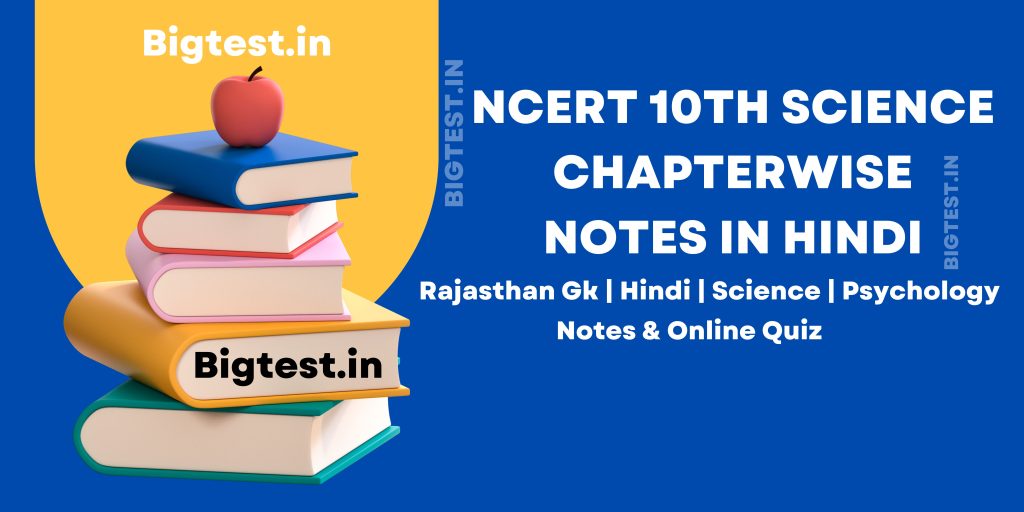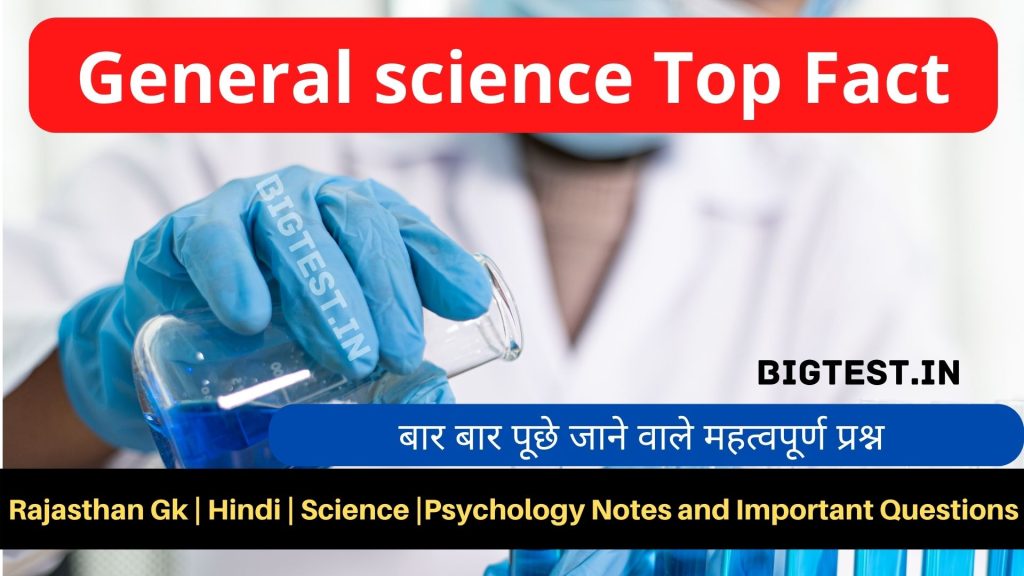नमस्कार प्रिय दोस्तों ! आज के इस पोस्ट में हम आपसे शेयर कर रहे हैं NCERT 10th साइंस के नोट्स चैप्टर वाइज (NCERT 10th साइंस चेप्टर वाइज नोट्स हिंदी में | NCERT 10th Science Chapter wise Notes in Hindi) दिए गए हैं | नीचे दी गई पोस्ट में चैप्टर वाइज पोस्ट के लिंक दी गई है | जिसमें संबंधित चैप्टर के पॉइंट पर क्लिक करके उस पोस्ट को पढ़ सकते हैं | RBSE 10th science नोट्स हिंदी में दिए गए हैं |यद्यपि पोस्ट लिखने में ध्यान रखा गया है , कि कोई त्रुटि ना हो फिर भी अगर कोई Topic संबंधी या किसी भी फॉर्मूला में त्रुटि होती है | तो आप हमें पोस्ट के अंत में कमेंट कर सकते हैं | यदि आपका कोई सुझाव हो तो आप हमें सुझाव भी भेज सकते हैं |
अब तक हमने 6 Chapters के ही नोट्स यहां प्रोवाइड करवाए हैं | आगे के चैप्टरों पर हम अभी कार्य कर रहे हैं | जैसे ही नोट्स उपलब्ध होंगे हम आपके लिए उनके लिंक भी इसी पोस्ट में अपडेट कर देंगे | Posts की अपडेट पाने के लिए वेबसाइट के राइट साइड में एक बैल आइकन दिया गया है | उस पर Touch करके आप हमारी वेबसाइट के अपडेट्स को सब्सक्राइब कर सकते हैं | ताकि जैसे ही हम कोई पोस्ट अपडेट करते हैं, आपको तुरंत सूचना मिल जाए |
RBSE 10th Science Chapterwise Important Notes in Hindi
अध्याय-1 रासायनिक अभिक्रियाएँ और समीकरण (Chemical Reactions And Equations)
- भौतिक व रसायनिक परिवर्तन | Physical and Chemical Changes
- Chemical Reaction | रासायनिक अभिक्रिया
- रासायनिक अभिक्रियाओं के प्रकार | Types of Chemical Reactions
- विकृतगंधिता व संक्षारण | Discoloration and Corrosion
अध्याय-2 अम्ल क्षारक लवण (Acids Bases Salts)
- अम्ल क्षारक व इनके गुणधर्म | Acid Bases and Their Properties
- लवण और लवण परिवार | Salt and Salt Family
अध्याय-3 धातु और अधातु (Metals And Non Metals)
- धातु और धातुओं के भौतिक गुणधर्म | Metal and Physical Properties of Metals
- अधातु और अधातुओं के भौतिक गुणधर्म | Non Metal and Physical Properties of Non Metals
- Chemical Properties of Metalsधातुओं के रासायनिक गुणधर्म
- धातुओं व अधातुओं की परस्पर अभिक्रिया | Interactions of Metals and Non-Metals
- Metals (धातुओं) का निष्कर्षण |Extraction of Metals
- धातुओं का परिष्करण | Metals Finishing
अध्याय-4 कार्बन और उसके यौगिक (Carbon And Its Compounds)
- कार्बन व हाइड्रोकार्बन | Carbon and Hydrocarbons
- हाइड्रोकार्बन का IUPAC नामकरण | IUPAC Nomenclature of Hydrocarbons
- क्रियात्मक समूह का IUPAC नामकरण | IUPAC Nomenclature of Functional Group
- Allotropes of Carbon | कार्बन के अपरूप
- कार्बनिक यौगिकों के रासायनिक गुणधर्म | Chemical Properties of Organic Compounds
- एथेनॉल व एथेनोइक अम्ल के गुणधर्म | Properties of Ethanol and Ethanoic Acid
- मिसेल निर्माण की क्रियाविधि | Mechanism of Micelle Formation
अध्याय-5 तत्वों का आवर्त वर्गीकरण (Periodic Classification Of Elements)
- तत्वों का वर्गीकरण | Classification of Elements
- डाॅबेराइनर का त्रिक नियम | Dobereiner triple law
- न्यूलैंड्स का अष्टक नियम | Newlands Law of Octet
- मेंडेलीफ का आवर्त नियम | Mendeleevs Periodic Law
- मोजले का आवर्त नियम | Mosleys Periodic Law
- आवर्त सारणी के तत्वों का ब्लॉक में वर्गीकरण | Block Classification of Elements of the Periodic Table
- Metals Non metals And Metalloids | धातु अधातु एवं उपधातु
- ब्लॉकों के प्रचलित नाम | Nicknames of Blocks
- परमाणु त्रिज्या व धात्विक त्रिज्या | Atomic Radius and Metallic Radius
- परमाणु त्रिज्या का आवर्त व वर्ग पर प्रभाव | Effect of atomic radius on period and class
- आयनिक त्रिज्या | Ionic Radius
- इलेक्ट्रॉन बंधुता | Electron Affinity
- विद्युत ऋणता | Electricity Indebtedness
- रासायनिक अभिक्रियाशीलता तथा आवर्तिता | Chemical Reactivity and Frequency
- परिरक्षण प्रभाव | Shielding Effect
- प्रभावी नाभिकीय आवेश | Effective Nuclear Charge
- अक्रिय गैस तत्व | Inert Gas Element
- प्रतिनिधि तत्व | Representative Element
- संक्रमण तत्व | Transition Element
- अंतः संक्रमण तत्व | Inter Transition Element
अध्याय -6 जीवन प्रक्रियाएं (Life Processes)
- सजीव और निर्जीव की परिभाषा व अंतर | Definition and Difference of Animate and Inanimate
- जैव प्रक्रम | Biological Process
- स्वपोषी पोषण व विषमपोषी पोषण | Autotrophic Nutrition and Heterotrophic Nutrition
- प्रकाश संश्लेषण | Photosynthesis
- मंड परीक्षण | Starch Test
- रंध्र की परिभाषा व कार्य | Definition And Function of Stomata
- अमीबा में पोषण | Nutrition in Amoeba
- मानव पाचन तन्त्र | Human Digestive System
- वायवीय और अवायवीय श्वसन | Aerobic And Anaerobic Respiration
- मानव श्वसन तंत्र | Human Respiratory System
- मानव में वहन | Carried in Human
- हृदय की संरचना एवं कार्यप्रणाली | Heart Structure And Function
- रूधिर में ऑक्सीजन तथा कार्बन डाइऑक्साइड का विनिमय | Exchange of Oxygen And Carbon-dioxide in the Blood
- रक्तदाब | Blood Pressure
- पौधों में जल का परिवहन | Transport of Water in Plants
- पौधों में भोजन का परिवहन | Transport of Food in Plants
- मानव में उत्सर्जन तंत्र | Excretion System in Humans
- अपोहन या कृत्रिम वृक्क | Dialysis or Artificial Kidney
- पादपों में उत्सर्जन | Excretion in Plants
अध्याय-7 नियंत्रण और समन्वय (Control And Coordination)
- नियंत्रण एवं समन्वय का अर्थ | Meaning of Control and Coordination
- तंत्रिका कोशिका अथवा न्यूरॉन का सचित्र वर्णन | Pictorial description of Nerve cell or Neuron
- प्रतिवर्ती चाप | Reflex Arc
- मानव मस्तिष्क का सचित्र वर्णन | Pictograph of Human Brain
- पादपों में समन्वय | Coordination in Plants
- अंत: स्त्रावी ग्रंथियां | Endocrine Glands
- पादपों में हार्मोन | Hormones in Plants
अध्याय -8 जीव कैसे प्रजनन करते हैं (How Do Organisms Reproduce)
Coming soon
अध्याय-9 आनुवंशिकता और विकास (Heredity And Evolution)
Coming soon
अध्याय-10 प्रकाश परावर्तन और अपवर्तन (Light Reflection And Refraction)
Coming soon
अध्याय-11 मानव आँख और रंगीन दुनिया (Human Eye And Colorful World)
Coming soon
अध्याय-12 बिजली (Electricity)
Coming soon
अध्याय-13 विद्युत धारा के चुंबकीय प्रभाव (Magnetic Effects Of Electric Current)
Coming soon
अध्याय-14 ऊर्जा के स्रोत (Sources Of Energy)
Coming soon
अध्याय-15 हमारा पर्यावरण (Our Environment)
Coming soon
अध्याय-16 प्राकृतिक संसाधनों का सतत प्रबंधन (Sustainable Management Of Natural Resources)
Coming soon
FAQs
Question 1. NCERT 10th साइंस बुक में कुल कितने चैप्टर है ?
Answer – 16 Chapter
Question 2. संक्रमण तत्व किसे कहते है ?
Answer – वे तत्व जिनके परमाणु या आयन के इलेक्ट्रॉनिक विन्यास में d – कक्षक अपूर्ण हो, संक्रमण तत्व कहलाते हैं | अथार्त d – ब्लॉक के तत्वों को संक्रमण तत्व कहते हैं |
Question 3. वायुमंडल में कार्बन की मात्रा कितनी होती है ?
Answer – 0.03%
Question 4. भूपर्पटी में कार्बन की मात्रा कितनी होती है ?
Answer – 0.02 %
Question 5. कार्बन किसे कहते हैं ?
Answer – कार्बन एक रसायनिक तत्व है, जिसका परमाणु क्रमांक 6 होता है तथा प्रतीक “C” होता है |
Some Topic Important Links
afterward read NCERT 10th साइंस चेप्टर वाइज नोट्स हिंदी में | NCERT 10th Science Chapter wise Notes in Hindi post you can read bellow important Notes
Science More Important Topics you can click here
Hindi More Important Topics you can read here
Rajasthan GK More Important Topics click here
Psychology More Important Topics you can read here
conclusion :- At least after reading this post, the general knowledge of NCERT 10th साइंस चेप्टर वाइज नोट्स हिंदी में | NCERT 10th Science Chapter wise Notes in Hindi will definitely increase.by all means you must read our website for gain your general knowledge. in a word subscribe our notifications for upcoming post. we collect best NCERT 10th Science Chapterwise Notes in Hindi for you guys. if you really like our work please share with your friends.

